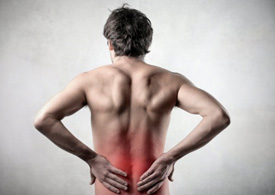Lower Back Pain
Are you alone in your back pain?
 Back pain costs the Australian economy about 9 billion dollars annually. Most people suffer from a bad back at some time in life and it is one of the main reasons people go to healthcare practitioners in Australia (1).
Back pain costs the Australian economy about 9 billion dollars annually. Most people suffer from a bad back at some time in life and it is one of the main reasons people go to healthcare practitioners in Australia (1).
Which treatments are shown to be effective?
New Australian research published 24th July, 2014 in ‘The Lancet'; one of the world’s most respected medical journals, has thrown the issue of back pain management into question.
In the past, medical management usually included advice to take Paracetamol and wait for the pain to go away. Now, the findings of a well conducted randomised controlled trial (RCT); the so called ‘gold standard’ of clinical evidence, has found Paracetamol, the most commonly recommended medication for back pain is no better than a placebo sugar pill (2).
New recommendations in the American Medical Association Journal
Meanwhile, spinal therapy (SMT), the treatment used by most chiropractors, has again been shown to be evidenced based and effective, this time published (2013) in the prestigious journal ‘Spine’ (5). Consequently the Journal of the American Medical Association (JAMA) recently included advice for people with acute low back pain to consider consulting a chiropractor.(6)
Why early treatment is now recommended
Additionally, spinal pain was thought to be largely self limiting and commonly, the advice was to take drugs in the form of anti-inflammatory medication and adopt a ‘wait and see approach.’ Unfortunately this is often not the reality. Approximately 25% of Australians who experience lower back pain continue to have persistent or recurrent episodic back pain (3).
Indeed, we are in a process of updating the old Australian Primary Care clinical guidelines. Recovery is often slower than expected, with “nearly one in three patients not recovering” This will obviously lead to chronic pain and increased healthcare costs (4).
Causes of Lower Back Pain
One of the greatest misconceptions in spinal health care is the notion that that most cases are a simple muscle strain. By definition, a muscle strain involves “torn muscle fibres”. Although this can occur in the spine, it is comparatively rare. Muscle spasm or contraction, along with inflammation is most commonly a side effect of the real causes.
Current research indicates back pain comes from three major sources:
- DISC INJURIES account for approximately 40%
- FACET JOINT Problems account for 15-40% of cases. (31% in other studies.)
- SACROILIAC Dysfunction account for 13-18% (7)
This leaves approximately 12-20% accounting for all other causes of lower back pain.
Including but not limited to, degeneration, ligament sprain, muscle strain, tumour, infection, autoimmune disorders and others such as fracture or spondylolisthesis.
Disc Injuries and Sciatica
 The term slipped disc is an incorrect but convenient term used historically. A disc slipping is actually impossible without destroying the bones they support.
The term slipped disc is an incorrect but convenient term used historically. A disc slipping is actually impossible without destroying the bones they support.
The Intervertebral disc is incredibly strong and can bear substantial weight over time.
However, once the disc has begun to lose water content the process of disruption begins. Disruption starts near the centre of the disc, so you’re not going to see it on a plain film x-ray or CT scan most of the time. An MRI scan will show a dehydrated disc, which is a prerequisite for internal disc disruption. The disc has a central nucleus, composed of a viscous mucopolysaccharide material. The nucleus is surrounded by concentric rings, termed the Annulus Fibrosis. These annular rings contain the constantly moving nucleus during its function of shock absorption, and movement of the spinal segments. Internal disc disruption and disc herniations have to start somewhere and in most cases they begin with an annular tear. This can allow the nuclear material to work its way through the rings towards the outside of the disc. Annular tears only become painful when they extend into the sensitive outer one third of the disc. However, the resultant scar tissue from previous damage can bring sensitive nerve fibres into the deeper aspects of the disc, resulting in further pain producing capacity.
Eventually, the nucleus can create a bulge of the outer rings of the annulus reducing the space for the nerves as they exit the spine or as they descend in the spinal canal. Further Damage may cause the disc nucleus to protrude and cause direct pressure and/or chemical irritation on a nerve. This commonly results in sciatica, which is the ‘nerve like pain’, which runs down the back of the thigh and into the lower leg. If the discs of the upper lumbar vertebra are involved, you may notice this ‘nerve like’ pain in the front of the thigh. A trained healthcare professional such as a chiropractor, should be able to diagnose which nerve is involved and advise or treat accordingly. This would involve a number of orthopaedic and neurological tests and in some cases imaging such as an MRI or CT scan is very helpful. It should be noted that not all disc protrusions cause symptoms and many people can lead a normal life with disc protrusions present. It is however, very wise to manage the integrity of this damaged area on an ongoing basis.
Referred pain down the leg is caused by a number of other conditions, which do not involve disc protrusion compromising a nerve. These would need to be differentiated by a trained healthcare professional. A chiropractor has a five-year degree with the purpose of these five years focused on being specialized in these conditions.
What should you do?
With 25-30% of acute low back pain episodes converting to chronic ongoing painful episodes, it makes good sense to have a thorough examination with a health care professional specializing in the spine. The old doctrine of ‘wait and see’ can lead to chronicity, which becomes more difficult to manage. Once this is achieved you are enabled to gain the best outcome through appropriate management.
- Have a positive attitude to good results. Expect to get well.
- Watch our videos on spinal exercises.
- Book in for our FREE Spinal Workshop by calling us, today!
- Stand up and move for 20 seconds every 20 minutes.
- Be active.
- If you suspect a disc injury or you have had previous episodes of pain, please see our attached PDF Caring for Lumbar disc Protrusion.
- Book in for a thorough examination by contacting us.
Flexion Distraction

Gently drawing apart each joint like an accordion allows the spine to reset, and the pumping action enhances soft tissue nutrition and rehabilitation.
This is a gentle, non-force adjusting approach. The thing that most patients notice first is our special table. The movements of this table help traction the spine, opening up compressed spinal discs and reducing pressure on facet joints of the spine.
Named after its developer, Dr. James Cox, this highly-effective technique combines osteopathic principles with the specific, highly-directed approach used in chiropractic. The combination offers a conservative resolution of low back and leg pain that often averts the need for surgery.
The Cox Flexion-Distraction technique we use gives us the ability to place spinal joints in a more normal motion and position without pain or aggravating your condition.
By lying on the table, neutralizing the effects of gravity, we’re able to gently separate spinal joints and move them through a more normal range of motion. Patients find this surprisingly pleasant. We find it powerfully effective.
- AIHW: Australian Institute of Health & Welfare disease expenditure database. Canberra: Commonwealth of Australia; 2013.
- Williams CM, Maher CG, Latimer J, McLachlan AJ, Hancock MJ, Day RO, Lin C-WC: Efficacy of paracetamol for acute low-back pain: a double-blind, randomised controlled trial. The Lancet 2014.
- Walker BF, Muller R, Grant WD: Low back pain in Australian adults. Health provider utilization and care seeking. Journal of manipulative and physiological therapeutics 2004, 27(5):327 – 335.
- Henschke N, Maher CG, Refshauge KM, Herbert RD, Cumming RG, Bleasel J, York J, Das A, McAuley JH: Prognosis in patients with recent onset low back pain in Australian primary care: inception cohort study. BMJ 2008, 337.
- Goertz CM, Long CR, Hondras MA, Petri R, Delgado R, Lawrence DJ, Owens EF, Meeker WC: Adding chiropractic manipulative therapy to standard medical care for patients with acute low back pain: results of a pragmatic randomized comparative effectiveness study. Spine (Phila Pa 1976) 2013, 38(8):627-634.
- Goodman DM, Burke AE, Livingston EH: Low back pain. JAMA 2013, 309(16):1738-1738.
- DePalma, Michael J MD; Ketchum, Jessica M PhD; Ruchala, Monkia; Kouchouk, Amr; Powell, David; Trussell, Brian S MD. Prevalence of disc, facet joint or sacroiliac joint pain in low back pain patients utilizing an algorithmic APPROACH: GP100. Spine: Affiliated Society Meeting Abstracts:
October 2010 – Volume – Issue – p 242
We’re happy to field phone calls to answer any question not answered here.
